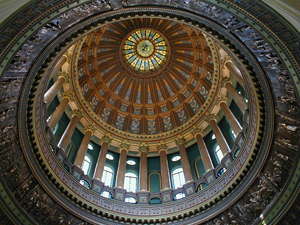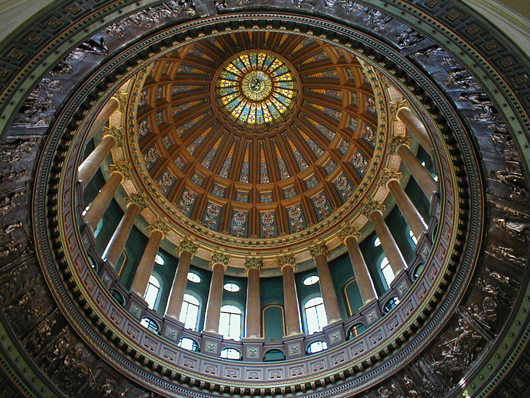
SPRINGFIELD, Ill. (AP) – Oh, if these walls could talk.
No doubt the Illinois State Capitol could tell stories of political intrigue, deal-making, grand ideas—both the inspired and the incompetent—and, yes, corruption.
If there is one person alive who still can hear those stories, it’s Mark Sorensen.
Sorensen is retired from the Illinois State Archives, and during the preparations for the capitol’s 100th birthday in 1988, he pulled together information about the building and its history to make it more accessible to the public.
He retired in 2002 and lives in Decatur now, but they still know him around the statehouse. Even present-day tour guides defer to his expertise and stand aside when they walk into a room and find him already sharing stories about the building’s history.
In the late 1860s, other cities were trying to lure the highly coveted designation of state capital away from Springfield.
Springfield already had outfought Kaskaskia and Vandalia for the honor, but state government had outgrown the Old State Capitol and plans were being formulated to build a new statehouse.
“In 1867, Decatur tried to become the capital, and Springfield fought to keep it,” Sorensen says.
Even after construction started in 1868, other cities kept trying to wrest the state capital, with its power and government jobs, away from Springfield.
The building of the Capitol was fraught with delays, changes in building plans and funding shortfalls. Construction took a decade, and when the building finally opened in 1877, it wasn’t finished. The state didn’t have the money.
“The Constitution of 1870 was passed after they started construction here,” Sorensen says. “They kept having hearings (in 1878) over corruption and other problems, and the Constitution limited the amount of funds that could be spent in an attempt to limit any possible corruption.”
Two referenda to raise the money needed to finish the building failed. Finally, in 1884, a referendum passed to provide the necessary $531,712.
In the meantime, other cities kept circling.
“Chicago and Peoria tried to take the capital away while there was just the first concourse of stone up here,” he says. “The General Assembly went to Peoria for a couple of days on a drinking spree to tour facilities in Peoria and then rode the train back here.
“They were going to go to Chicago—they had gone up there for a couple of meetings in the past—but before they could meet in Chicago, Chicago burned down.”
After that, Peoria’s offer was turned down, and work continued on the building in Springfield.
The Capitol that opened in 1877 was much different than today’s ornate building.
The main floor was considered the basement then, with a grand staircase leading up to the second (or executive) floor.
Sorensen says the floor was wooden and the basement housed mundane storage and offices like weights and measures.
“The whole Capitol rotunda was naked because they didn’t finish it,” Sorensen says. “You could see all the way up to the outside cupola. There was no skylight or anything.”
In 1886, the stairs to the second floor were torn down and a balcony created outside the governor’s office. The former basement became the entrance.
At about that time, the building was decorated and the walls hand-painted.
Computer-generated wallpaper has replaced the wall paintings in wings of the building that already have been restored.
“The importance of the Capitol is it is a museum inside a working building, so you have these conflicts between preserving art and architecture and making this a functional building for offices and people who have jobs working in state government,” Sorensen says.
“When the building was built, it contained every aspect of state government—three museums, art galleries, the military arm of the government was centered here, the justice department—the Supreme Court, all the state officials,” he says.
“And since that time, just about every one of those officials have moved to offices outside of the Capitol, have their own buildings. The museums and libraries have moved to other facilities.”
Since the 1960s, the general assembly has taken over most of the space in the building.
The Capitol, with its large dome, rotunda and ornate decoration, draws visitors beyond those with official government business.
“Everybody that comes in for the first time is amazed,” Sorensen says. “You will see that as you stand off to the side as they walk in.
“You see their head immediately snap up and they will make some sort of noise—‘ooh,’ ‘ahh’ or ‘wow,’” he says. “I guess that’s the answer as to why people should come here.”
Talking with a tour group in the old Supreme Court Room at the Capitol, Sorensen tells the story behind a mural on the ceiling.
“Two artists from St. Louis executed this painting in the 1870s showing Goddess of Justice in front of the Illinois State Capitol, trampling on a cornucopia of gold coins because if you are from Illinois, you know justice cannot be bought.”
The anecdote brings laughter from the group.
___
Information from: The State Journal-Register, http://www.sj-r.com
Copyright 2012 Associated Press. All rights reserved. This material may not be published, broadcast, rewritten, or redistributed.
AP-WF-03-07-12 1133GMT
ADDITIONAL IMAGE OF NOTE



